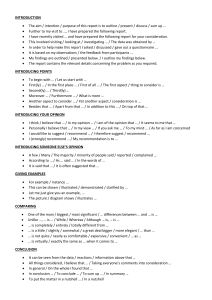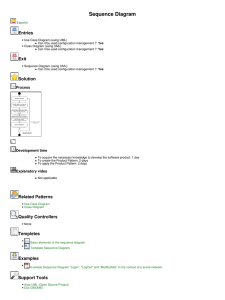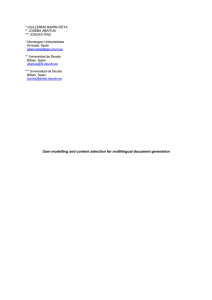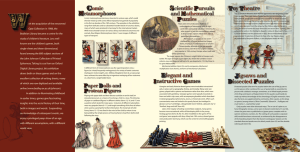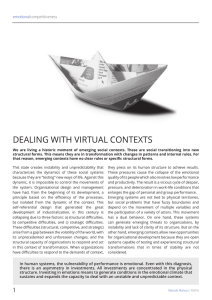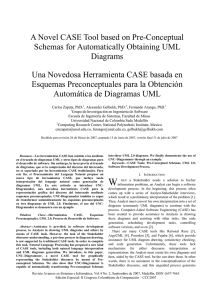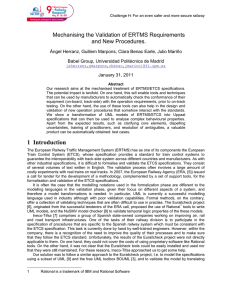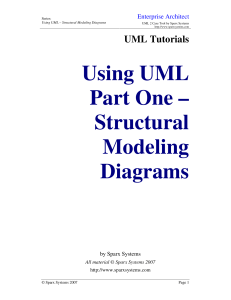Evaluation of UML Extensions for Aspect Oriented Design
Anuncio
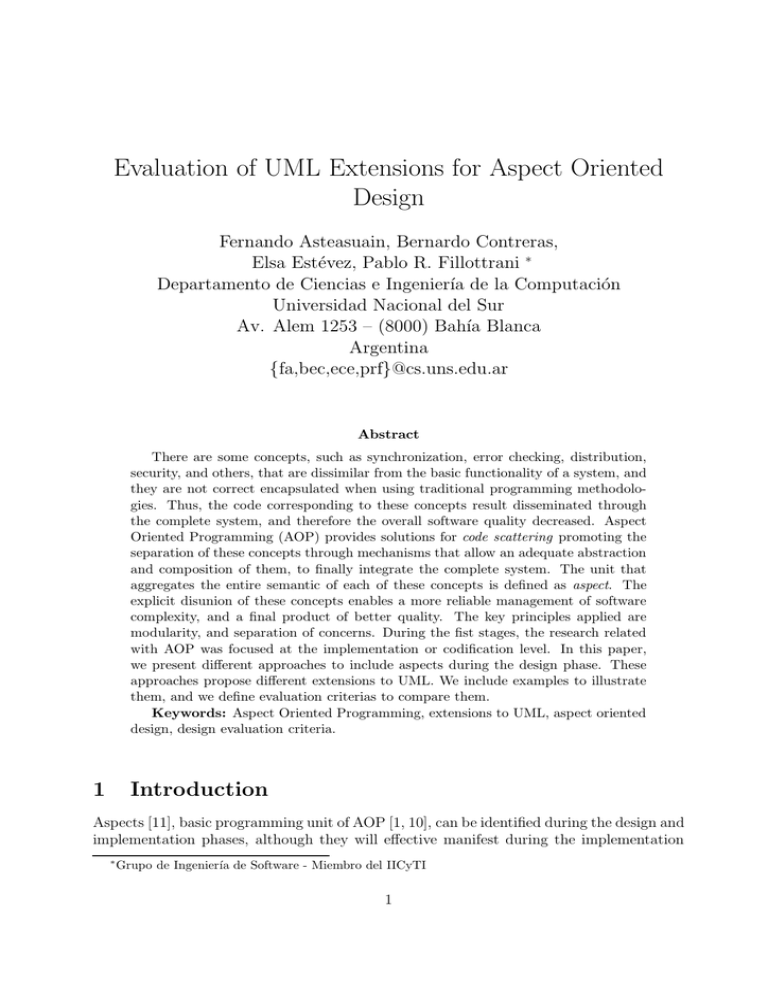
Evaluation of UML Extensions for Aspect Oriented
Design
Fernando Asteasuain, Bernardo Contreras,
Elsa Estévez, Pablo R. Fillottrani ∗
Departamento de Ciencias e Ingenierı́a de la Computación
Universidad Nacional del Sur
Av. Alem 1253 – (8000) Bahı́a Blanca
Argentina
{fa,bec,ece,prf}@cs.uns.edu.ar
Abstract
There are some concepts, such as synchronization, error checking, distribution,
security, and others, that are dissimilar from the basic functionality of a system, and
they are not correct encapsulated when using traditional programming methodologies. Thus, the code corresponding to these concepts result disseminated through
the complete system, and therefore the overall software quality decreased. Aspect
Oriented Programming (AOP) provides solutions for code scattering promoting the
separation of these concepts through mechanisms that allow an adequate abstraction
and composition of them, to finally integrate the complete system. The unit that
aggregates the entire semantic of each of these concepts is defined as aspect. The
explicit disunion of these concepts enables a more reliable management of software
complexity, and a final product of better quality. The key principles applied are
modularity, and separation of concerns. During the fist stages, the research related
with AOP was focused at the implementation or codification level. In this paper,
we present different approaches to include aspects during the design phase. These
approaches propose different extensions to UML. We include examples to illustrate
them, and we define evaluation criterias to compare them.
Keywords: Aspect Oriented Programming, extensions to UML, aspect oriented
design, design evaluation criteria.
1
Introduction
Aspects [11], basic programming unit of AOP [1, 10], can be identified during the design and
implementation phases, although they will effective manifest during the implementation
∗
Grupo de Ingenierı́a de Software - Miembro del IICyTI
1
or codification activities [6]. When aspects appeared during the implementation, software
engineers add or remove them easily due to the plug-in plug-out nature of the elements of
this paradigm. In contrast, for those aspects identifiable during the design phase it is not
possible to take action, and we should only wait until the codification phase. Thus, this
fact promotes the need to develop mechanisms and tools that enable aspect manipulation
and specification during the design phase.
Including a special aspect specification during the design, simplifies the development of
aspect oriented software facilitating different concerns. First, documentation and learning
are facilitated. Considering aspects as design constructors, software engineers can recognize
them in a higher level of abstraction and during an early stage of the development process.
Aspect designers and software engineers initially involved in AOP can learn and document
models in a more intuitive fashion. Second, it promotes aspect reuse. The way in which
aspects are documented and further studied , the considerations about how aspects are
designed, and how they depend on the abstractions associated to them, is crucial for aspect
reuse. Finally, it promotes evolutionary development. If aspects are considered during
the design phase, it is possible to produce incremental aspect oriented software. Briefly,
the considerations and motivations for considering aspects during the design phase are
semantically equivalent to those that justify to include the design phase during traditional
software development.
Kande et al. [5] define two main topics needed to evaluate an aspect oriented design
model. First, the model needs to define clearly which are the elements that crosscut the
basic functionality. Without this information, the representation and reasoning about
aspects structure and its behavior in the system is difficulty. Second, it needs to provide
mechanisms and means to separate the elements that crosscut functionality from basic
system components, and also must encapsulate these elements in a special artifact.
The most direct and natural approach is to investigate UML adaptability [7], as a
specification language for aspect modeling. UML is the design language most accepted in
software engineering, and is considered as a standard. It provides a powerful set of modeling
tools for system analysis and design, for the definition of the system architecture, and also
for specifying the system behavior. It also provides, a set of mechanisms to extend or
adapt UML to a specific domain. This extensibility characteristic make it more suitable.
In this paper, we analyze UML for specifying aspect oriented design. In the next
section, we discuss if UML, as it is defined, is able to express aspects, and if it is able to
satisfy the two topics mentioned by Kande et al. These concepts are shown by an example.
In section 3 we evaluate two approaches to manipulate aspects during the design phase,
based on different UML extensions. In section 4, we present different design evaluation
criteria to compare these approaches. Finally, we present our conclusions and future work.
2
UML for Aspect Oriented Design
Suppose we need to model a system for the following requirements. We consider two classes
Client, and Supplier. The Supplier class includes a method invoice(q:int) that is used to
store the different invoices that the supplier receives from the clients. One of the system
requirements stipulates that is needed to save all the information related to the requests
2
Figure 1: Log Aspect: saves the requests to a Supplier
that the supplier receives from his clients. This requirement is a concept that crosscut
different parts of the system, and its code will be diseminated among several classes. The
implementation of this requirement is naturally supported by an aspect oriented development. The Log aspect will be responsible for the implementation of this requirement and
is shown in Figure 1.
The aspect introduces the method initLog in the Supplier class. This method creates
the file where all the information about invoices will be saved. The file is managed through
the file attribute, which is also introduced by the aspect in the Supplier class. The semantic
for the Connection Point and for the Notice defined in the aspect is quite simple: after
each request to the method invoice of the Supplier class, the relevant information is saved
on the file. Figure 2 shows the class diagram for the example.
Figure 2: Static structure of the aspect semantic
.
The collaboration diagram may be used to model the dynamic structure of the system.
The diagram shown in Figure 3 shows a behavioral view based on the interactions between
an object c from Client class and an object s from Supplier class. The object c invokes
3
the method invoice defined in s, shown by the arrow labeled with invoice(). One approach
to show the aspect semantic, is to apply the technique used to model interceptions to
method invocations [5]: it consists of adding a new class whose instances are interposed
between the interacting objects. The application of this technique is shown in Figure 3. An
interceptor objetc i is placed between the client and the supplier. The object i implements
the logging aspect, and also has an interface that supports all the methods of the Supplier
class that can be invoked by the Client class, plus a mechanism to resend the invocations
intercepted to the Supplier class.
Figure 3: Dynamic structure of the aspect semantic
.
UML, as it has been shown, admits the structure and the interactions modeling of the
aspect oriented system. Although, the resultant models suffer important disadvantages [5].
First, the crosscutting concepts are not modeled correctly. The design of the logging aspect
results disseminated all over the system because it is partially modeled with the Logging
interface and the association bewtween File and Supplier classes. The dymanic of the
system is represented by an object of the Intercept class, that interchanges messages with
objects of other classes. Second, the diagrams do not show differences in class modularization and aspect modularization. The specific concepts of Aspect Oriented Programming,
such as Connection Points, or Notices are not explicitly modeled. Third, the model does
not reveal the fact that the interception to the method invocation is done transparently.
Finally, the model does not show the property “plug-in plug-out” of the Logging aspect.
In the following section we evaluate different UML extensions.
3
UML Extensions for Aspects Managing
There are two alternatives to extend UML in order to manage aspects. One of them is
the General Extension to UML (GEU). It modifies the meta model of UML to include at
this level the concepts related to the paradigm. Thus, UML will be able to model all type
of aspects in any situation and in any context. Hence, aspects will be first level objects
because they will be predefined mechanisms of the language, such as classes. Consequently,
it will be possible to construct correct and simple models with enough level of abstraction.
The disadvantage of this approach is that in order to be so general, perhaps some concepts
related to the aspects may be lost during modeling. To solve this problem, a different
4
approach was proposed. It consists on a Specific Extension to UML (SEU) that prioritizes
the understandability of the problem and aims to reduce complexity. In this approach,
design is not done for any aspect, just only for the aspects in the current system. Therefore, a model that reflects more closely the problem is obtained, and this model presents
higher level of abstraction. The disadvantage is that when changing to another problem,
it will not be possible to reuse anything of the previous products, and we must start from
the beginning again. In being so specific, if we change the environment, the extensions
constructed to one system will not serve to the other, making difficult the reuse.
This discussion is the same that raises when developing an aspect oriented language
[2]. Should the development consider aspects in general, or only those specific to the
problem? These alternatives are well known in literature as General Purpose Aspect
Oriented Languages, and Specific Aspect Oriented Languages. The decision of which one
should be selected during the design phase is the same: both alternatives are valid, but
depending on the application domain, one of them will be the most convenient.
In the next subsections we present both alternatives.
3.1
General Extension to UML
Suzuki y Yamamoto [4] propose a general approach to express aspects during design. They
suggest an extension to UML to support aspects appropriately without violation to the
meta model specification. For this purpose, they add to the meta model new elements for
the aspect and the weaver [1, 2] , and an existing element is reused to model the relationship class-aspect.
3.1.1
Aspects
Ideally, the aspect should be a constructor derived from the Classifier element, describing its structure and behavioral properties. The Class, Node, Interface, and Component
elements are Classifier types, such as Aspect should be. An aspect can have attributes,
operations and relationships. The aspect operations are used to express its behavior. The
aspect relationships include generalization, dependence, and associations. Figure 4 shows
the proposed extension for the aspect constructor.
Figure 4: An aspect as a metamodel element
.
5
3.1.2
Class-Aspect Relationship
The UML Metamodel defines three primary relatrionships derived from the metamodel
element Relation. These are the associations, the generalizations and the dependencies.
Considering that the dependency relationship stipulates that the implementation of one
element requires the presence of other element or elements, we consider this type of relation
the most adequately to model the class-aspect relationship.
The properties derived from the dependency element are: abstraction, bound, permission, and use. The class-aspect relationship is a type of abstraction. An abstraction
dependency relates two elements that corresponds to the same concept in two different
levels of abstraction, or from two different points of view. The UML Metamodel defines
four stereotypes for the abstraction dependency: derivation, realization, refinement and
trace. The most appropriate is the << realization >> stereotype. A realization is a
relationship between an element of the specification model, and the element of the model
that implements it.
3.1.3
Weaver
Using a weaver, the aspect code and the class code are combined, generating a weaver
class. The structure of this class depends on the weaver and on the base language used.
To express it in the metamodel, an stereotype << W eaver Class >> is introduced to the
Class element. It is advisable to use a labeled value to specify the aspect, and the class or
classes asociated to it.
3.2
Specific Extension to UML
In [3], UML is extended to support the synchronization aspect. Each object is designed
in two levels: a functional level where the basic functionality of the object is defined, and
the synchronization level, where the synchronization properties are described. Without
UML extensions, the synchronization policies are not explicitly modeled, consequently
they result simply in code written in the body of the methods.
The mechanisms that UML provides for posible extensions are used to extend UML
[7]. These are stereotypes, constraints, and labeled values. The stereotypes provide a
mean for elements classification, adding new attributes, relationships, and operations. The
constraints enable the specification of new semantic for the model elements. The labeled
values permit to associate information to any model element.
A new stereotype << Synchronization >> is defined to represent the synchronization
policies. All the synchronization semantic is represented by its atributes and methods.
Also, a new type of state diagram is described to model the dynamic structure, such
as synchronization conditions, state changes, and each of the event constraints. This new
diagram is known as state diagram for synchronization. The construction rules are:
• A synchronization state represents a set of methods that can be invoked at any time.
6
• A transition represents a relationship between two states. It indicates that an object
in a state can change to other state when an event occurs. A transition between two
synchronization states will happen only when a method is invoked.
• The transition condition evaluates the possibility to execute the transition. Thus, it
evaluates the possibility to execute the method.
Finally, the synchronization actions are defined. They are classified in two categories:
pre-actions, and post-actions. The pre-actions are the set of actions that must be executed
before the method invocation, and the post-actions are the set of actions that must be
executed after the method invocation. All this information is added to the transition.
Figure 5 shows the transition scheme.
Figure 5: Transition scheme for an UML extension
As an example, we consider a chat server. The server provides several methods, two
of them are the connection and the disconnection methods. The synchronization policy
stipulates that it will be possible to establish a connection if the server is not overloaded.
This means that the number of connections already established are less than the maximum
bound.
First, we define the Server Sync class with the << Synchronization >> stereotype.
It implements the synchronization policies for the server methods invocation. In this case,
it only involves an attribute counter, for the registration of the number of connections, and
two methods increase and decrease, to manipulate the counter. In Figure 6 we show the
static structure of the system.
Figure 6: UML Extension: Synchronization stereotype
As it was mentioned, a state diagram for synchronization is required to show the dynamic behavior. This diagram is related with the Server Sync class and defines the synchronization policies required. Figure 7 shows such diagram.
We have presented in this section two approaches based on extensions to UML for
aspect oriented design. In the next section we define evaluation criteria to compare them.
7
Figure 7: State Diagram for syncronization of Server class
4
Evaluation of Both Approaches
To compare both alternatives we follow the criterias defined in [9]. These criterias are used
to evaluate how each approach satisfies the considerations mentioned in Section 2. The
criterias are:
• Traceability: how easy is to follow the requirements in the design models. This
criteria is defined to ensure that the design approach has provided the adequate
constructors.
• Propagation of Change: how the model facilitates the incorporation of future changes
in the design.
• Reuse: how it promotes design reuse for other systems.
• Understandability: how the design facilitates the understanding of the system functionality.
• User Friendliness: how the design techniques are easy to learn and use.
• Separate Development: how the design techniques enables parallel development of
different modules of the system. This criteria promotes a better productivity of the
development team.
In the next subsections we eavluate the two approaches presented, based on these
criterias.
8
4.1
Traceability
The SEU approach provides a good traceability as a result of the separation of the static
and dynamic behavior. Within the static models, stereotypes and relationships are used,
objects, aspects, and also how they are related are clearly specified. Within the dynamic
models, new state diagrams are defined, where the actions related to aspects are captured
by pre- and postactions related to a transition. These actions enable the modeling of those
requirements that crosscut the design.
In the GEU approach, each paradigm concept has its associated constructor. This is
a main characteristic because in this way the connection point notion is explicit. This
one-to-one relationship between the paradigm concepts and the language constructors is
very importat because it produces a perfect traceability. This situation is not present in
the SEU approach where several concepts, such as the connection points are modeled in
an implicit way.
4.2
Propagation of Change
The SEU approach shows a weak point in the dynamic behavior modeling. As all the
actions related to aspects are specified within the transitions, a change or modification
implies a review to all the state diagrams to check the modification.
In the GEU approach, this problem is not present because of the one-to-one relationship
between concepts and constructors. Although, the disadvantage is that aspects have an
excesive view and control of the internal structure of the objetcs related to them. Thus,
the effects of a change can be rapidly propagated. The fact of controlling and restrict this
strong influence of the aspect over the object is a responsability concern of a good designer.
4.3
Reuse
In the SEU approach, while the aspect results correctly encapsulated, such encapsulation
is mainly based on the current system, presenting all its constraints and characteristics.
Mostly, the decissions are taken considering the current context. Thus, to move the aspect
to other system, with other properties, is a complex task.
In the GEU approach, as the aspects and their objects elements are first classes in
the model, richer and more expressive models can be produced. Therefore, promoting the
alternative to model aspects inheritance, abstract aspects, and other characteristics. As a
result, a good reusability of aspect designs is obtained.
4.4
Understandability
In the SEU approach, the understandability is vey good working with models with few
aspects, because it is based on well known and familiar constructors. As more aspects
appear it results more difficult to identify the relationships between aspects, and between
aspects and their objects.
The GEU approach does not provide clear composition rules, and also exists a strong
9
influence of aspects over objects. These two characteristics reduce the design understandability.
4.5
User Friendliness
In the SEU approach, the extensions to manage aspects are realised with the own mechanisms provided by UML for extension. Thus, extended models preserve simplicity. With
solid knowledge of UML and its extension mechanisms, it is simply to apply those mechanisms to aspect handling and learning. This approach is quite easy to use, and also is easy
to understand the system behavior.
In the GEU approach, as new elements are added to provide a general solution, they
require more attention about their behavior, and also the way in which they can be used
and composed. Thus, it is necessary a previous learning stage, not trivial, before using
them. Therefore, the learning and user friendliness is considerably reduced.
4.6
Separate Development
In the SEU approach, as simplicity is prioritized, the aspects interaction is essentially
reduced, enabling a separate development of all the aspects involved in the system.
In the GEU approach, because of a greater interaction between aspects and objects, and
also because of the aspect design references to the objects related, separate development
is seriously affected.
In the next section we present our final conclusions and future work.
5
Conclusions and Future Work
In this work we have presented the need for expressing aspects in the first stages of the
development process, particularly during design. It represents the first main step for the
consolidation and definitly maturity of AOP.
First, we have anlyzed if UML, the most popular and accepted specification language in
software community, as it is defined is able to express aspects. The conclusion is that it is
possible to represent aspect semantics, but the way to express them is not so satisfactory.
Thus, the next step was to study different approaches to extend UML. A general and
formal alternative is to include the paradigm concepts in the language metamodel. The
other alternative, not so rigorous, but also effective, is to extend UML for the currrent
problem, using the mechanisms that UML provides to extend its semantic.
In the first approach, aspects are treated during the design phase in a more formal
and general fashion. With this extension, it is possible to express in UML any aspect
that appears in the system at any moment. Also, when changing to another system, and
having to manage different aspects, the same extensions will serve to model the new system.
Although granularity is not so good, there are good benefits with respect to documentation,
learning, reusability, and formality.
In the second approach, a specific extension to UML was defined to manage the synchronization policy for the functional behavior of the objects of the system. To model
10
Criteria
Traceability
Propagation of Change
Understandability
User Friendliness
Reuse
Separate Development
GEU
Excellent
Sufucient
Suficient
Regular
Good
Good
SEU
Suficient
Bad
Regular
Excellent
Bad
Very Good
Table 1: GEU and SEU Evaluation
the static structure, we create a new stereotype << Synchronization >>, and for the dynamic structure a new state transition diagram was added. Thanks to these extensions, the
synchronization policies can be designed separatly and independently, enabling a greater
reuse. The abstraction level was correct, and the concepts related with synchroniuzation
resulted clearly encapsulated. As it was mentioned, this extension is usable only for the
synchronization aspect. For other aspects, new stereotypes and new state diagrams should
be considered.
We compared both extensions based on particular criterias. In table 5 we resume the
result of each approach for each of the criterias, based on our analysis. We have used to
following scale: Excelent, Very Good, Good, Suficient, Regular, and Bad.
In a little system, with a controlable number of aspects, namely no more than five plus
or minus two, the SEU approach is a direct way, simple and effective. Although, when
the system complexity increases, and the number of aspects is important, the simplicity
of SEU is a disadvantage for the developer. In this situations is when it reveals that this
approach is an ad-hoc solution, an approach to solve a particular situation. As it was also
mentioned in [8], SEU is a compromise solution , a solution not conceptually robust.
We believe that the main issue behind aspect oriented design is to consolidate the GEU
approach, in such a way that it can satisfy all the criterias mentioned. The future work is
to study its weakness and to look forward to improve them, specially facilitating its use,
making it more adaptable to changes, and more understandable.
As far as we know, the research made about including aspects during the design phase,
as those presented in this paper, try to solve a particular problem, in an isolated way.
The different appraches are quite different, they do not respect standards, they include
different stereotypes, and there is no consensus. The main contribution of this work is an
attempt to unify different approaches, and to guide the developer in decidig the aspect
oriented design strategy.
Our future work is to study automated tools able to generate code from models containing aspects. Thus, tools that take as input an UML model, then ask all the information
required for the elements, and finally generate an application skeleton. Those tools should
consider the aspect language, but also the language where the basic functionality will be
expressed.
11
References
[1] Aspect-Oriented Programming. In Proceedings of the European Conference on ObjectOriented Programming (ECOOP), Finland. Springer-Verlag LNCS 1241. June,1997.
Gregor Kickzales, John Lamping, Anurag Mendhekar, Chris Maeda, Cristina Videira
Lopes, Jean-Marc Loingtier, John Irwin.
[2] Programación Orientada a Aspectos: Análisis del Paradigma. Final Thesis for the
Bachellor Degree in Computer Science. Universidad Nacional del Sur. November, 2002.
Fernando Asteasuain, Bernardo Ezequiel Contreras.
[3] Introducing Separation of Aspects at Design Time. In Proceedings of AOP Workshop
at ECOOP ’00, Cannes, France. June, 2000. José Luis Herrero, Fernando Sánchez,
Fabiola Lucio, Miguel Toro.
[4] Extending UML with Aspects: Aspect Support in the Design Phase. 3er AspectOriented Programming(AOP) Workshop at ECOOP ´99. Junichi Suzuki, Yoshikazu
Yamamoto.
[5] From AOP to UML- A Bottom-Up Approach. Software Engineering Laboratory,
Switzerland. June, 2001. Mohamed M. Kandé. Jorg Kienzle, Alfred Strohmeir.
[6] Generative Programming: Principles and Techniques of Software Engineering Based
on Automated Configuration and Fragment-Based Component Models. Ph.D. Thesis,
Technische Universitat Ilmenau, Germany, 1998. K. Czarnecki.
[7] UML: The Unified Modeling Language. Addison Wesley, 2000. Grady Booch, James
Rumbaugh, Ivar Jacobson, Rational Software Corporation..
[8] A Metamodel for Aspect-Oriented Modeling. Workshop on Aspect-oriented Modeling
with the UML. First Conference of Aspect-oriented Software Development (AOSD
2002), Holland. April, 2002. Christina Chavez, Carlos Lucena.
[9] An Analysis of Design Approaches for Crosscutting Concerns . Workshop on Identifying, Separating and Verifying Concerns in the Design (AOSD 2002), Holland. April,
2002. R. Chitchyan, I. Sommerville, A. Rashid.
[10] Programación Orientada a Aspectos: Metodologı́a y Evaluación. IX Congreso Argentino de Ciencias de la Computación CACIC, Octubre 2003 Fernando Asteasuain,
Bernardo Contreras, Elsa Estévez, Pablo R. Fillottrani.
[11] Getting Started with AspectJ . Communications of the ACM (CACM) Vol. 44 Nro.10,
Octubre 2001. Gregor Kickzales, Erik Hilsdale, Jim Hugunin, Mik Kersten, Je.rey
Palm, William G.Grisnold.
12
